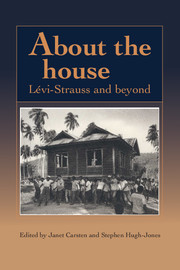Book contents
- Frontmatter
- Contents
- List of illustrations
- List of contributors
- 1 Introduction
- 2 Houses and hierarchies in island Southeast Asia
- 3 The resurrection of the house amongst the Zafimaniry of Madagascar
- 4 The hearth-group, the conjugal couple and the symbolism of the rice meal among the Kelabit of Sarawak
- 5 Houses in Langkawi: stable structures or mobile homes?
- 6 Having your house and eating it: houses and siblings in Ara, South Sulawesi
- 7 The Lio House: building, category, idea, value
- 8 Houses and hierarchy: the view from a South Moluccan society
- 9 Houses, places and people: community and continuity in Guiana
- 10 The houses of the Mẽbengokre (Kayapó) of Central Brazil – a new door to their social organization
- 11 Inside-out and back-to-front: the androgynous house in Northwest Amazonia
- Notes
- Bibliography
- Index
7 - The Lio House: building, category, idea, value
Published online by Cambridge University Press: 05 June 2012
- Frontmatter
- Contents
- List of illustrations
- List of contributors
- 1 Introduction
- 2 Houses and hierarchies in island Southeast Asia
- 3 The resurrection of the house amongst the Zafimaniry of Madagascar
- 4 The hearth-group, the conjugal couple and the symbolism of the rice meal among the Kelabit of Sarawak
- 5 Houses in Langkawi: stable structures or mobile homes?
- 6 Having your house and eating it: houses and siblings in Ara, South Sulawesi
- 7 The Lio House: building, category, idea, value
- 8 Houses and hierarchy: the view from a South Moluccan society
- 9 Houses, places and people: community and continuity in Guiana
- 10 The houses of the Mẽbengokre (Kayapó) of Central Brazil – a new door to their social organization
- 11 Inside-out and back-to-front: the androgynous house in Northwest Amazonia
- Notes
- Bibliography
- Index
Summary
‘HOUSE-BASED SOCIETIES’ – A GENERALLY APPLICABLE CATEGORY?
In his discussions about the social and symbolic role of the House, Lévi-Strauss was mainly concerned with finding a structuring principle common to cognatic (or ‘undifferentiated’) societies (Lévi-Strauss 1983a, 1987). As is well known, the idea that the House might constitute such a principle came through his re-examination of Kwakiutl social organization – a topic which had been puzzling anthropologists for some time because of the apparent lack of clear categories. Accordingly, he suggested that the House could be understood as a ‘moral person’ and be defined in terms similar to those used to define a noble house in the Middle Ages in Europe, that is, as ‘a corporate body holding an estate made up of both material and immaterial wealth, which perpetuates itself through the transmission of its name, its goods, and its titles down a real or imaginary line, considered legitimate as long as this continuity can express itself in the language of kinship and affinity and, most often, of both’ (1983a: 174). In addition, he pointed out that Houses in this sense frequently possess goods of supernatural origin (1983a). Initially, for Lévi- Strauss, the explanatory strength of Houses as encountered in cognatic societies was that they united a whole range of contradictory tendencies. Thus ‘patrilineal descent, matrilineal descent, filiation and residence, hypergamy and hypogamy, close marriage and distant marriage, hereditary and election: all these notions, which usually allow the anthropologist to distinguish the various types of society, are reunited in the House’ (1983a: 184).
- Type
- Chapter
- Information
- About the HouseLévi-Strauss and Beyond, pp. 149 - 169Publisher: Cambridge University PressPrint publication year: 1995
- 10
- Cited by

